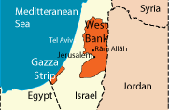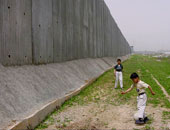A brief history of the struggle
Article by Rachael Thornley
At the beginning of the 20th century the region now known as Israel/Palestine was part of the Ottoman empire, under Arab rule. After the Crimean war the empire had been left deeply in debt and was forced into submission to the Allied Powers. France and Britain held the empire under mandate (administrative control), which resulted in the region being fragmented into independent, but easily controllable states (Lebanon, Egypt, Iran, Iraq, Syria, Jordan and Saudi Arabia). The boarders were arbitrarily enforced, a continuing point of conflict today in the region. In addition, the British, after the 1st World war, had promised the Jewish Zionist movement a homeland within the boarders of what is contemporary Israel/Palestine. This initial agreement (the Balfour Agreement 1917) signed in secrecy, became the basis of the Jewish move to populate and eventually to gain administrative control over the country. It was not laid out to dispossess the already existing Arab population, at the time 700,000 strong, but to create a state tolerant of both Arab and Jewish civil liberty and religious belief. However, due to the rapid immigration of large numbers of relatively wealthy Jews from Europe leading up to the holocaust and the subsequent land acquisition by the Jewish community, the majority of Arabs were left landless and disenfranchised.
The self-proclaimed sovereignty of the land of Israel in 1948 inflamed the surrounding Arab nations to declare war. They were easily defeated, despite their numbers, due to the superior resources of the Israeli army, thus increasing Israel’s territory further. Despite the losses to the Arabs they did manage to secure The Gaza Strip and the West Bank. During this time almost 400,000 Palestinians fled fearing for their lives assuming that within a short period they would be returning to their homes. Most never did even after the UN called ‘The Right of Return’ but were accommodated in, what at the time were considered ‘temporary’, refugee camps on Israel’s boarders. The only neighbouring Arab nation to accept the Palestinians was Lebanon, although even there they were not granted full citizenship, rather they were used as pawns within the Arab world’s conflict with Israel.
Up to this point the Palestinians had little formal political representation but from exile a sense of solidarity grew within Refugee camps, resulting in the formation of the Palestine Liberation Organization (PLO) in 1964, which secured a base in Jordan. It proclaimed: The right of the Palestinian people of their homeland;
That this right would be achieved through Military struggle;
That the Israeli state was illegally formed;
That there would be no compromise to the total liberation of Palestine;
And that racist and fanatical Israeli Zionists were the source of all conflict in the region.
It was with these philosophies, which were actualised through the guerrilla outlet ‘Fatah’ (run by Yasser Arafat), that the organisation conducted the armed struggle against the state of Israel. Through violent acts of self-assertion they brought their claim to the world stage and earned themselves the status of world terrorists. In 1967 The Popular Front for the Liberation of Palestine was formed, a more radical organization that theorized that the struggle should include any means including the high jacking of planes and other acts of terror. Although the two groups shared common ideological ground, often the approaches of the PFLP alienated international support and in order to legitimise itself, the PLO publicly criticised its fellow Palestinian organisation.
Increasing tensions between Israel and it’s neighbours over water supplies, trade routes and the use of demilitarised zones for farming, accumulated in the 1967 ‘6 Day War’. Egypt, Syria, Jordan and Iraq formed an alliance to combat Israel’s activities but a pre-emptive attack on the Egyptian air force seriously impeded the Arab nations’ chance of victory and within 6 days they retreated, leaving Israel in control of the West Bank, the Gaza Strip and Golan Heights. After this event Palestinian groups realised that they could not rely on their Arab brothers for support against Israel and sought to gain further independence. This resulted in increased violence from the PLO and challenges to Jordanian authority, which eventually led to their expulsion from the country (an event named ‘Black September’) and their relocation in Lebanon, where they continued their assaults on Israel. The Lebanese had become more sympathetic to the Palestinian plight after Israel’s seizure of Arab territory in 1967 and allowed the PLO to gain power, creating a virtual state-within-a-state. The threat this poised to Israel was great and they retaliated with attacks on Lebanon forcing the country to impose restrictions on Palestinian activity. Israel invaded the country in 1978 but was forced to retreat by the UN, who also served as a check on the increasingly authoritative PLO, which by this time had grown vast. In 1982, the Israeli’s launched another attack on Lebanon, destroying Palestinian refugee camps and forcing PLO troops back into Beirut. The PLO eventually pulled out of the city to prevent further casualties, leaving the administrative section of the PLO completely exposed to the Israeli army. The result was the deaths of thousands of Palestinian civilians and the loss of much of the PLO’s strength. After 1982, the PLO relocated to Tunis (Tunisia), although it never fully regained it’s former power.
At this time Palestinian living conditions in the West Bank and the Gaza Strip worsened; they were denied social services, access to and control over their own resources and their business ventures were regulated, resulting in a vicious cycle of poverty. The Israeli government, seeking to eliminate Palestinian resistance, used violence on the civilians to instil fear and humility. Their actions soon provoked an uprising which the Palestinian’s called the ‘Intifada’ meaning ‘shaking off’ in Arabic. They boycotted Israeli goods, embarked on strikes and encouraged attacks on occupying troops. Israel responded heavy-handedly with tear gas and imprisonments. The events were broadcasted on the International news, provoking a worldwide sympathy for the Palestinians. This was the trigger for the UN two state resolution of 1988, which Arafat accepted, publicly denouncing terrorism and forfeiting many aspects of the original PLO ideology. However, to the shock of the UN, Israel rejected the proposals, continuing the violence.
Palestinian support for Iraq in the 1990 invasion of Kuwait lessened their international standing and greatly reduced Gulf Arab support of their cause. The 1993 Oslo Peace Treaties, which followed on from the Gulf war, hoped to create a new era of peace in the region, but after 7 years, still the Palestinians had not tasted freedom. This amounted to a second Intifada, triggered by, the then, Israeli Defence Minister Ariel Sharon, who entered into the Noble Sanctuary in Jerusalem accompanied by 1,000 police officers. The Israel reaction to this uprising was more brutal than the last, involving the firing of rubber bullets and imposed curfews which left the Palestinians virtually imprisoned within their homes.
In 2002 the UN and US formed ‘The Road Map for Peace’ calling for the formation of two sovereign states in the region. A goal that was to be reached by 2005, with the formation of a Palestinian cabinet and Prime Minister, and the promise of the complete end to attacks on Israel by both the Palestinians and neighbouring Arab nations. The main obstacle was that much of the occupied territories had now been illegally settled by Israeli civilians and Israel refused to withdraw them from this land. The building of by pass roads had further fragmented the territories making the act of unifying them more difficult. Despite ongoing modification of the Road Map and discussions between the PLO, Israel and the UN, little has improved. The settlement of the West Bank and Gaza has continued, as have the counter attacks on Israel. Further aggravating the situation in 2002, Israel began the construction of a partition fence, which cuts deep into the occupied territories. According to Israel it is designed to keep out the terrorists but is undoubtedly reducing the likelihood of a resolution to the problem.
The above account is, admittedly, a gross summary of the crisis. Understanding claims over the land of ‘Palestine’ requires a thorough history lesson of the region which is beyond the scope of this particular website. More information can be found through the following web addresses and literature in the information bar.





